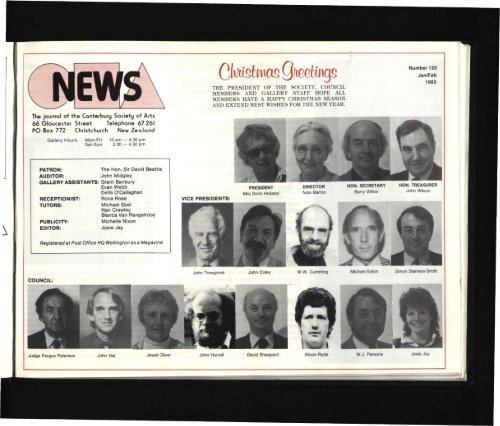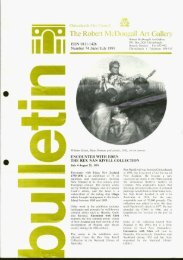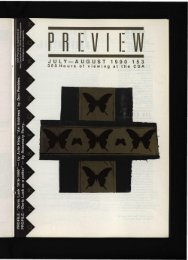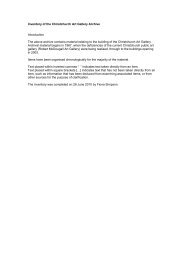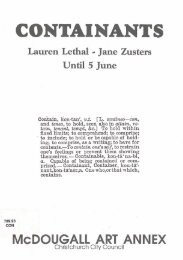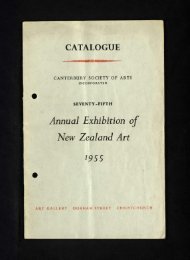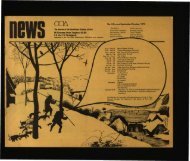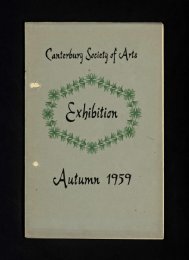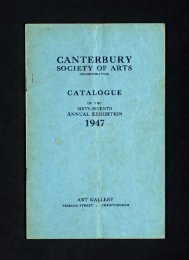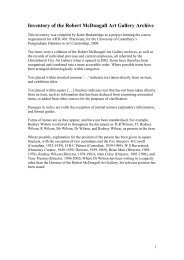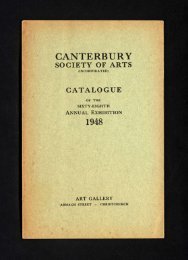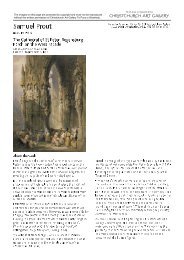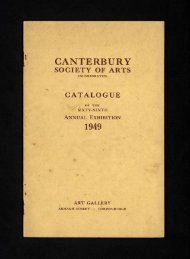Download (6.2 MB) - Christchurch Art Gallery Te Puna O Waiwhetu
Download (6.2 MB) - Christchurch Art Gallery Te Puna O Waiwhetu
Download (6.2 MB) - Christchurch Art Gallery Te Puna O Waiwhetu
Create successful ePaper yourself
Turn your PDF publications into a flip-book with our unique Google optimized e-Paper software.
The journal of the Canterbury Society of <strong>Art</strong>s<br />
66 Gloucester Street <strong>Te</strong>lephone 67 261<br />
PO Box 772 <strong>Christchurch</strong> New Zealand<br />
<strong>Gallery</strong> Hours Mon-Fri<br />
Sat-Sun<br />
10 am<br />
2.00<br />
• 4.30 pm<br />
4 30 pm<br />
PATRON:<br />
The Hon. Sir David Beattie<br />
AUDITOR:<br />
John Midgley<br />
GALLERY ASSISTANTS: Grant Banbury<br />
Evan Webb<br />
Delia O'Callaghan<br />
RECEPTIONIST: Rona Rose<br />
TUTORS:<br />
PUBLICITY:<br />
EDITOR:<br />
Michael Ebel<br />
Nan Crawley<br />
Bianca Van Rangelrooy<br />
Michelle Nixon<br />
Josie Jay<br />
Registered at Post Office HQ Wellington as a Magazine<br />
COUNCIL:<br />
VICE PRESIDENTS:<br />
Ctetmas yiteefjmgg<br />
THE PRESIDENT OF THE SOCIETY, COUNCIL<br />
ME<strong>MB</strong>ERS AND GALLERY STAEF HOPE ALL<br />
ME<strong>MB</strong>ERS HAVE A HAPPY CHRISTMAS SEASON<br />
AND EXTEND BEST WISHES FOR THE NEW YEAR.<br />
PRESIDENT<br />
Mrs Doris Holland<br />
DIRECTOR<br />
Nola Barron<br />
Number 120<br />
Jan/Feb<br />
1985<br />
HON. SECRETARY HON.TREASURER<br />
Barry Wilkie John Wilson<br />
John Trengrove John Coley WW. Cumming Michael Eaton Simon Stamers-Smith<br />
Judge Fergus Paterson John Vial Jewel Oliver John Hurrell David Sheppard Alison Ryde W.J. Parsons Josie Jay
PRINTS ...<br />
RESTORING ...<br />
For Selection . . .<br />
F I S H E R S<br />
ART DEALERS SINCE 1870<br />
ORIGINALS ...<br />
We offer a COMPLETE SERVICE -<br />
SELLING—BUYING—VALUATIONS-<br />
EXPERT CLEANING-RESTORING<br />
GILDING AND ANTIQUE<br />
H. FISHER & SON LTD<br />
Fine <strong>Art</strong> Dealers 691 Colombo Street<br />
(Between Cashel and Hereford Streets)<br />
Holiday Hours<br />
The gallery will be closed from Monday, December 24, until<br />
Saturday, January 5, 1985. It will re-open in the afternoons<br />
only until Friday, January 18 when normal hours will resume.<br />
Children's <strong>Art</strong> Classes<br />
A holiday art workshop for children will be held on each<br />
morning of the 22, 23, 24 and 25 January, 1985.<br />
Fees: $10 members, $12 non-members.<br />
Please phone the gallery to enrol, and pay before<br />
January 18.<br />
1985 Children's Saturday<br />
Morning Classes<br />
Enrolment for the first term closes on February 1. Parents<br />
should pre-enrol by phoning the gallery (67-261) and<br />
confirm by paying fees before February 1 to ensure a place.<br />
Fees $24 members, $27 non-members. 1985 classes<br />
begin at 9.30 a.m. on February 9.<br />
<strong>Art</strong> Books<br />
We are grateful for the receipt from the estate of the late Mr<br />
and Mrs Stewart Mair of art books and magazines, as well as<br />
documents relating to the building of the new gallery. Some<br />
of these have been given to the MacDougall <strong>Art</strong> <strong>Gallery</strong> to<br />
increase their holding of archival material on Australian<br />
artists and other books may interest our members.<br />
Should you wish to look at or borrow a book please ask at<br />
the office.<br />
<strong>Art</strong>ists Easels<br />
We have been advised of the manufacture of artists easels<br />
of different designs and a wooden carry compact for<br />
materials.<br />
There is a brochure on our noticeboard or you may contact<br />
Riverland Industries.<br />
I. McNally Street<br />
PO Box 249<br />
PHONE: 5709 ASHBURTON<br />
"From Farmgates to Picture<br />
Frames"<br />
Roger Hickin's picture frames have been described as<br />
"weathered wood jewelled with nails". Another reviewer has<br />
termed them "contrived".<br />
Worked mostly from wirebrushed weathered farm timber,<br />
these distinctive frames were seen most recently in<br />
<strong>Christchurch</strong> around Ralph Hotere's 1984 stainless steel<br />
pieces.<br />
In these and earlier collaborations such as the one pictured,<br />
the frames form a part of the imagery of the work as a whole,<br />
but they also work in a less obtrusive/more conventional<br />
sense, for example: as a sensitive edge to recent Rakaia<br />
River paintings of G.T. Moffitt and wild Otago Harbourscapes<br />
of Anna Caselberg. While Roger finds that his frames<br />
provide an authentic embrace ("a frame is a kind of<br />
embrace") for works such as these, he feels he is able to<br />
make frames (both rough wire-brushed ones and more<br />
highly-finished oiled ones) to suit many kinds of work,<br />
originals and prints. He may be contacted at 88 Richardson<br />
<strong>Te</strong>rrace, Opawa, ph. 897-607.
New Zealand Sculpture<br />
Survey 1965-1984<br />
A Comprehensive survey covering the work of some 60<br />
sculptors, including documentation of all facets of New<br />
Zealand Sculpture. Each sculptor provided 5 slides<br />
representative of their work, together with a personal<br />
statement as background reference; biographical details<br />
and an outline of their ideas.<br />
Survey price $165. Order forms available from: Ken Adams,<br />
N.Z. Sculpture Survey, Lynfield College, White Swan Road,<br />
Mt. Roskill, Auckland 4.<br />
UNIVERSITY RESEARCHER WOULD GREATLY<br />
APPRECIATE INFORMATION ABOUT, AND LOCATION<br />
OF, NEW ZEALAND STILL LIFE AND FLOWER-PAINTING<br />
BETWEEN 1880-1940.<br />
ALL REPLIES DEALT WITH IN STRICT CONFIDENCE.<br />
Contact: Ann Elias<br />
c/- Dept. <strong>Art</strong> History<br />
Private Bag<br />
Auckland University<br />
Four Piano Recitals<br />
by Charles Martin<br />
on Thursdays from March 7, 1985,<br />
between 12.15 p.m. and 1.15 p.m.<br />
The <strong>Gallery</strong> will be sponsoring a further series of Recital-<br />
Lectures by Mr Martin.<br />
His programme will include sonatas by Beethoven; suites by<br />
MacDowell, Coleridge-Taylor, and Greig; airs with variations<br />
by Beethoven, Handel and Hummel. Arrangement of<br />
airs such as "Greensleeves" by Vaughan Williams will be<br />
included in the programme.<br />
Mr Martin is well-known for these recitals, and the C S A<br />
warmly supports them, and cordially invites your attendance<br />
at them.<br />
Admission:<br />
$5.00 for the whole series.<br />
$1.50 for single recitals.<br />
Please phone 67-261 or call at the <strong>Gallery</strong> to enrol.<br />
Nine Tubes<br />
"In sixteen weeks I can teach them everything," says<br />
Michael Ebel, tutor of the CSA's adult art classes.<br />
He has concentrated next years' courses into two stages<br />
each of eight weeks' duration. As part of his aim to make<br />
painting "as simple as possible" he restricts the students to<br />
nine tubes of paint each (which, as he points out, also works<br />
out cheaper). With these nine tubes they can mix all the<br />
colours they'll need.<br />
He compares painting to cooking or gardening.<br />
"There's nothing mystical about it. There are certain<br />
ingredients which you can put together as you like."<br />
But you must know which ingredients to use. If you don't, he<br />
warns, you'll have the same results as a would-be gardener<br />
who doesn't know water is necessary to make plants grow.<br />
Michael questions the concept of innate artistic talents. He<br />
believes everybody is, or has the potential to be, an artist.<br />
"There isn't a single person you can't teach the ingredients<br />
of the theory of painting to."<br />
His teaching methods involve giving people the facilities and<br />
knowledge to enable them to do what they want to do, not to<br />
follow any particular style, but to "paint like themselves".<br />
At the end of the course he has noted that the paintings<br />
"end up looking like the people who paint them".<br />
There are usually about twelve people to a class mostly<br />
women since classes are held during the day. Everyone, no<br />
matter what their previous experience, starts from the<br />
beginning.<br />
Anyone interested in next year's classes should ring the<br />
gallery for more information and dates. Classes will begin in<br />
February.<br />
by Michelle Nixon<br />
MERIVALE<br />
VILLAGE<br />
FLORIST<br />
Ruth Bain<br />
Diploma N.Z.P.F.<br />
Shop 4<br />
Merivale Mall<br />
Papanui Road<br />
<strong>Te</strong>lephones 559-738<br />
After Hours<br />
557-253 or 528-577<br />
MALING & CO<br />
WINE MERCHANTS<br />
86 GLOUCESTER STREET<br />
Bin ome a \ riend<br />
795-470<br />
ROBERT M (<br />
DOUGALL<br />
ART GALLERY<br />
Brochures available from CSA<br />
The McDougall <strong>Gallery</strong> or Secretary<br />
<strong>Te</strong>lephone 487-482
Selling <strong>Gallery</strong><br />
What could be more truly original as a Christmas present<br />
than a painting or artist's print from the CSA's extensive<br />
stock?<br />
Original paintings ranging from early works by Cecil Kelly<br />
to contemporary artists such as Emily Jackson — the<br />
gallery staff are delighted to help people find something<br />
to suit their home or office. <strong>Art</strong>ists whose work is<br />
available from the Selling <strong>Gallery</strong> include:—<br />
Cecil Kelly early works<br />
Rata Lovell-Smith<br />
Emily Jackson<br />
Doris Lusk<br />
Margaret Woolley<br />
Heather Person-Hill paintings<br />
Owen Lee<br />
Valerie Heinz<br />
John Coley<br />
Wallace Crossman<br />
Sally Eden<br />
Neil Frazer<br />
Derek Margetts<br />
Philip Trusttum<br />
Also new prints by Gordon Crook<br />
Margaret Elliot, Makara North Aspect.<br />
Dreams and Illusions<br />
The gallery is mounting an exhibition of prints and<br />
photographs entitled "Dreams and Illusions" in the new<br />
year.<br />
Barry Cleavin, tutor in printmaking, and photography tutor<br />
Lawrence Shustak, both of the University of Canterbury<br />
School of Fine <strong>Art</strong>s, have recommended the artists invited to<br />
submit work. Printmakers and photographers from all over<br />
the country will participate in what promises to be an<br />
interesting and stimulating exhibition.<br />
The preview will be held at 8 p.m. on February 27, and the<br />
exhibition will run till March 10.<br />
Autumn Exhibition for<br />
Working Members<br />
Receiving date for work submitted for the Autumn members'<br />
exhibition is April 1, 1985. Preview on April 3.<br />
Summer <strong>Art</strong> School<br />
Waikato Society of <strong>Art</strong>s<br />
7th-11th January<br />
TUTORS: Carole Shepheard — an experimental workshop<br />
that explores symbols and imagery in a variety of ways.<br />
Susan Poff — watercolour and drawing.<br />
Stanley Palmer — printmaking — monoprinting, woodcutting<br />
and etching.<br />
Course Fee — $95.<br />
Enrolment — Waikato Summer School<br />
School of <strong>Art</strong><br />
PO Box 1018<br />
HAMILTON. Ph 394-481.<br />
The New Zealand Academy<br />
of Fine <strong>Art</strong>s<br />
Caltex <strong>Art</strong> Award 1985<br />
Landscape<br />
An exhibition of painting, drawing and sculpture showing<br />
wilderness and rural scenes and activities in New Zealand<br />
Last Receiving Day — Tuesday 29th January.<br />
Season — 24 February-17 March.<br />
Entry forms available from: —<br />
The Director,<br />
N.Z. Academy of Fine <strong>Art</strong>s,<br />
Private, Bag,<br />
Wellington.<br />
The New Zealand Academy<br />
of Fine <strong>Art</strong>s<br />
BNZ <strong>Art</strong> Award 1985<br />
Pots: Sculpture: Prints<br />
An exhibition of pottery, sculpture, photography and limitec<br />
editions of artist's prints.<br />
LAST RECEIVING DAY: Tuesday 9th March.<br />
Season — April 14-28<br />
Entry forms available — address some as above.<br />
^HiBs civ<br />
Stfb<br />
"Because a work does not aim at reproducing natural<br />
appearances it is not therefore, an escape from life — but<br />
may be a penetration into reality, not a sedative or drug,<br />
nor just the exercise of good taste, the provision of<br />
pleasant shapes and colours in a pleasing combination,<br />
not a decoration of life, but an expression of the<br />
significance of life, a stimulation to greater effort in<br />
living."<br />
— Henry Moore —
Views and Reviews<br />
Reflections on Forgery<br />
by Or. Denis Dutton<br />
Elmyr d'Hory, Han van Meegeren, Tom Keating: not the most<br />
celebrated names in the history of modern art, but individuals who<br />
in their way managed to earn a good deal of begrudging respect.<br />
Each was a successful practitioner of an art as old as<br />
connoisseurship itself - the art of forgery. Forgery is a topic<br />
which excites continual interest both in and out of the art world,<br />
and as I have come recently to find out, it remains a topic capable<br />
of arousing some strong - and hard - feelings.<br />
Last year I published an anthology dealing with the purely<br />
aesthetic aspects of art forgery. By a stroke of luck, The<br />
Forger's <strong>Art</strong> (University of California Press) appeared just at the<br />
time of the furor about the Hitler diary forgeries, and as a<br />
consequence the book received a great deal more media<br />
attention in Britain and the United States than it would otherwise<br />
have enjoyed. Most contributors to The Forger's <strong>Art</strong> were, like<br />
myself, academic philosophers, thinkers accustomed to the<br />
imaginative consideration of the odd or extreme - in this instance<br />
some extreme cases of human chicanery and gullibility. The<br />
question they set out to examine was, What difference does it<br />
make if a treasured art work, one which has perhaps hung for<br />
years on a museum wall and given delight to generations of<br />
viewers, is revealed one day to be a forgery? Some of the<br />
contributors argued that who painted a work can make no<br />
aesthetic difference; whether a work is authentic or forged strictly<br />
speaking must be thought of as aesthetically irrelevant. Others,<br />
such as myself, argued that a work's status as original or forged<br />
can, and sometimes must, affect our aesthetic response to the<br />
work.<br />
Without going into the details of these complex - and<br />
sometimes philosophically technical - arguments, it seemed plain<br />
to me, and indeed to the clear majority of reviewers of the book,<br />
that a central issue in the philosophy of art was being raised by<br />
the authors, one which addressed the very question of what in<br />
the end we consider art to be. But here is where events took a<br />
most intriguing turn. For two or three magazine editors who had<br />
received copies of the book sent it out for review not to<br />
academic art historians or philosophers, but to art dealers. The<br />
results were interesting indeed!<br />
Though the book was widely and, pleasant to report, favourably<br />
reviewed, it especially raised the ire of the art dealers who wrote<br />
about it. An art dealer in San Diego dismissed The Forger's <strong>Art</strong><br />
by likening the arguments to the medieval debate about angels on<br />
pinheads, while perhaps the most curious review was a long one<br />
by the well-known New York art dealer, E.V. Thaw. He found it<br />
"appalling" that there should be so much discussion among<br />
philosophers of such a "non-issue" as forgery. After all, he<br />
explained, "very few fakes penetrate the defenses" of<br />
scholarship and the educated eye, and of those that do the vast<br />
majority are "minor and marginal" works. Worse than that, the<br />
book was "dangerous" in the way it promoted a "Philistine"<br />
sensibility.<br />
Thinkers back to Socrates have learned - often to their dismay<br />
- that being dangerous is a lamentably frequent characteristic of<br />
philosophical reflection. But the emotional level of Thaw's reaction<br />
reveals some peculiar things about the nature of the art world.<br />
Clearly, The Forger's <strong>Art</strong> struck a nerve. But why all the<br />
passion? In this respect, some light can be shed on the problem<br />
by engaging in a little thought experiment. Consider the situation<br />
of forgery in the arts of literature and music. What if, for example,<br />
it were discovered that, say, the Schubert Second Symphony or<br />
Dostoyevsky's A Raw Youth were not created by these artists,<br />
but were works by second-rate contemporaries? Some people,<br />
especially scholars who could have invested good portions of<br />
their careers examining and interpreting these works, might be<br />
upset. The libraries or individuals who own the original autograph<br />
manuscripts of these works would be disappointed by the news<br />
but that would be of little import, since the market in such<br />
autograph manuscripts is not large. And histories of Romantic<br />
music and Russian literature would have to be rewritten<br />
accordingly.<br />
But we could expect there would be little of the emotion - the<br />
changes and counter-charges, the angry denunciations - which<br />
almost inevitably characterize such revelations in the world of<br />
painting. The reason, I think, is not that something like the<br />
Schubert Second Symphony is less important in the history of<br />
music than a purported Corot may be in the history of painting:<br />
rather, it is that nobody owns the Schubert symphonies, or any<br />
other uncopyrighted work of literature or music. Disputes about<br />
the authenticity of such works arise less frequently than in the<br />
realm of painting only because there is little incentive to forge<br />
them (even the Hitler forgeries had to have a market to make their<br />
production worthwhile). If, let us imagine, music and literature<br />
were arts that produced unique material objects, objects which<br />
could be owned by individuals or museums - if, for example, one<br />
of the Beethoven quartets were housed in Chicago, while London<br />
held Madame Bovary (and was as unlikely to return it to its<br />
homeland as the Elgin Marbles) - then we could expect<br />
disagreements about musical and literary authenticity to be as<br />
loud and protracted as similar debates about Rembrandts and<br />
Picassos.<br />
tip: P3CT3RE §T)0P<br />
i Campbell Grant 196 Hereford Street, <strong>Christchurch</strong><br />
ARTISTS - have your pictures framed in our<br />
specialist shop (near Latimer<br />
Square) Large range of Mouldings<br />
10% discount for C.S.A.<br />
Members.<br />
Fine Jewellery<br />
in gold and silver<br />
Guenter Taemmler<br />
by<br />
C S A <strong>Gallery</strong><br />
66 Gloucester Street<br />
Carina Jewellers<br />
Caratelle Jewellery<br />
15 Chancery Lane<br />
Merivale Mall<br />
Antiques 1<br />
Genuine and Professionally<br />
ualified Antique Restorers and<br />
Healers are themselves very rare in<br />
New Zealand.<br />
But t here is one such firm in<br />
<strong>Christchurch</strong>.<br />
They are John Morrison and<br />
his son Ross who are top of<br />
the tree in their unique<br />
profession. Both John and<br />
Ross would welcome you to<br />
visit them at work and<br />
answer your quest ions on<br />
antiques and show you some<br />
of the magnificent piecec<br />
they have.<br />
CALL NOW<br />
OR PHONE 790-408<br />
UCMHeiO°<br />
5 UVIWGt?<br />
of Victoria &ntiqueg<br />
8 LIVINGSTONE STREET<br />
(Oil Fil2gerald Ave, between Lichfield Ave and Tuam Si
Paintings become property, and property has monetary, as well<br />
as aesthetic value So it was that I found with The Forger's <strong>Art</strong><br />
that even to raise as an abstract philosophical problem the<br />
question of the aesthetic relevance of forgery was to touch if not<br />
the nerves of art dealers, then apparently their pocketbooks. A<br />
few years ago a British television group began production of a<br />
series of programmes on forgeries. They found that they had no<br />
difficulty gaining the cooperation of major British dealers and<br />
auction houses, so long as it was thought that the programme<br />
was to be a series on art. As soon as they mentioned their<br />
interest in forgery, doors were closed, phone calls went<br />
unanswered, and many of the people who deal with art in Britain<br />
were generally unavailable for comment. Such experience does<br />
not increase one's sense of confidence in those who trade in art<br />
as merchandise, nor in my case does E.V. Thaw's shrill<br />
insistence that forgery is not a problem, since the educated eye<br />
- presumably his and his fellow dealers - can spot important<br />
fakes.<br />
Han van Meegeren: The Adulteress (1943). After van Meegeren<br />
sold this "Vermeer" it ended up in the private collection of<br />
Hermann Goering. A few days after the end of the war, van<br />
Meegeren was accordingly arrested for having sold a Dutch<br />
national treasure to the enemy. It was only then that he revealed<br />
himself as the painter of a whole series of forgeries of Dutch<br />
Masters.<br />
The problem we all feel is that educated eyes, particularly when<br />
they have a pecuniary interest in the works they assess, can see<br />
more what they want to see than what is actually there. This has<br />
been demonstrated in such famous cases as that of Han van<br />
Meegeren, the modern Dutch forger whose "Vermeers" were<br />
lauded as outstanding additions of the body of seventeenthcentury<br />
Dutch painting when they first came to light in the late<br />
1930s. Dutch museums for a while were in virtual competition to<br />
acquire these paintings, which to us in easy retrospect look<br />
pretty awful indeed. Yet so proud were the scholars and curators<br />
of these canvases that one was even suggested as the greatest<br />
of all the works of Vermeer.<br />
Forgery is a crime, and ought to be so considered. But not only<br />
does the forger commit fraud against some unsuspecting<br />
individual, what is worse, he falsifies our view of the history of art.<br />
The van Meegeren forgeries, had they continued to succeed,<br />
would have required a radical alteration of our view of the oeuvre<br />
of Vermeer, and moreover seventeenth-century Dutch art in<br />
general. And who knows what treasured "standards" might not<br />
have the origins conventionally ascribed to them? The greatest<br />
danger, of course, is not modern forgeries, "old" paintings done<br />
from scratch, but of the intentional or inadvertent misattribution of<br />
the works of minor artists. Sophisticated techniques exist to apply<br />
to minor works the signatures of major artists, thereby vastly<br />
increasing their monetary, if not aesthetic value. How common<br />
this is is difficult to say, since the successful cases are, by<br />
definition, undetected, and many detected cases, human nature<br />
being what it is, go unreported. What dealer or collector or<br />
curator wants, after all, to admit having been bamboozled?<br />
The van Meegeren episode is often recounted with an air of<br />
smug triumph: look what happened to those snobs and experts!<br />
But we all ought to take the tale as cautionary. Forgers have a<br />
way - it's their job - of playing not simply on our gullibility, but on<br />
our vanity as well. Van Meegeren carefully studied the art<br />
historical writings of his time in order to devise paintings which<br />
would perfectly fulfil scholarly expectations about what sort of<br />
Vermeers might turn up in the present century. Moreover, like<br />
every other forger, his works inevitably carry the stamp of his<br />
own time. He gave the European sensibility of the 1930s<br />
paintings which fit exactly how it wanted to see Vermeer. The<br />
vision presented was not so much an imitation of Vermeer's as it<br />
was an invention - and what was invented was a 1930s image of<br />
how Vermeer ought to have seen the world. Little wonder that<br />
some critics were willing innocently to claim that these newly<br />
discovered "Vermeers" were the finest of all the paintings of the<br />
Master of Delft. They were the most accessible to contemporary<br />
eyes.<br />
And who can be certain that there isn't at work in some studio<br />
in Fairlie or Hokitika an antipodean van Meegeren, providing a<br />
hungry New Zealand market with Gulleys and Goldies, canvases<br />
which may in their way appeal to us more even that the authentic<br />
Han van Meegeren: Lady and Gentleman with Spinet (1932).<br />
works of these artists? Laugh if it pleases - but don't forget to<br />
cast a glance over the mantlepiece!<br />
Editors note: Dennis Dutton, formerly Professor of Philosophy<br />
at the University of Michigan, now teaches the philosophy of art<br />
in the School of Fine <strong>Art</strong>s, University of Canterbury. He is Editor<br />
of the journal Philosophy and Literature.
The Summer Landscape,<br />
pruned to please<br />
Reviewed by Pat Unger<br />
The Summer Exhibition of 1984 contains approximately one<br />
hundred and fifty works (selected from over two hundred) by<br />
ninety-six artists and the resulting diversity presents a<br />
problem for review.<br />
How can such a group of unrelated pictorial facts be<br />
reasonably approached to discuss? In the absence of any<br />
clearly defined styles or schools the works, by image, fall<br />
into five obvious categories. All too familiarily these divisions<br />
are land/seascape, vegetation, dwellings and outhouses,<br />
still lifes, and figure (human and animal) studies.<br />
The faithful gallery goer will be pleased to see the work of<br />
many familiar painters well represented. Owen Lee, Annie<br />
Baird, Rosemary Roake, Lily Lewis, Barbara Fowler, Kath<br />
van Tunzelmann, Mollie Aitkens, E.E. Deans and Gussie<br />
Fenton all have excellent examples of their style of work on<br />
show.<br />
Rainy Afternoon by Robyn Willett, Avenue the Groynes by<br />
Ngaio Stupples, He Died for Me by Paul Rees, Weeds by<br />
June Gibbs, South Wind by Colin MacLaren and The<br />
Hunter by Harry Phillips. All impressed me as works that<br />
utilise the unique quality of their chosen medium.<br />
The uncompromising clarity of Chancery Lane by Nathan<br />
Crossan achieved by the pen and ink dot technique stopped<br />
me instantly, as did Mapua Road by Dawn Barry. This<br />
painting shows the eyecatching but intolerant quality of<br />
acrylic and the impact is further reinforced by reducing the<br />
landscape to stylised elements. A real gallery work.<br />
Picnic Time by Daphne Rolston and North Easterly by<br />
Irene Ford both make use of established styles with different<br />
results. Picnic Time with its colour divisions, Cezanne type<br />
bushstrokes and hints of Cubism, but without a clear<br />
understanding of the theories behind their styles ends up as<br />
merely an exercise in design and colour, whilst North<br />
Easterly, with Matisse—like bushstrokes manages to<br />
sustain a feeling of movement and freshness in the work.<br />
Facet An egg tempera work by Josie Jay fails in comparison<br />
to Monday Morning Glenorchy also in egg tempera by Sam<br />
Mahon. His skill with this medium is obviously great and in<br />
his other work, The Administrators he gives us his unique<br />
view of a blighted working group of bureaucrats.<br />
Entire by Josie Jay in oil, after the style of Cezanne has<br />
what her egg tempera lacks, form brought to life by sparkling<br />
colour and an animated painterly surface.<br />
High Alpine Landscape Craigieburn by Michael Eaton is<br />
immaculately painted but the arbitrary elongation of the<br />
canvas gives an almost old-fashioned feeling to the Alps, as<br />
if being viewed through a revolving camera obscura.<br />
Worsely Spin <strong>Christchurch</strong> by Maurice Askew must be<br />
one of the most appealing landscapes in this Exhibition<br />
Whimsay, reason and a sense of design add up to a work of<br />
competence by an experienced artist, and at a most<br />
reasonable price.<br />
Works that do not fit into any of these categories are few and<br />
far between. Fallow a tightly knit composition and Oracle<br />
both by Keith Morant are pictorially satisfying.<br />
Ancient Space by Paul Drake, the back of which I must<br />
confess, I found structurally impressive and the Rite of<br />
Spring a wooden sculpture by L. Summers are both of<br />
interest, but not necessarily for their overt imagery. What<br />
are the Rites of Spring?<br />
Isolde Lew Summer's other submission is of a massive<br />
floating woman carved in totara on a marble base. The<br />
compactness, along with the grossness of this work help to<br />
create a feeling of tension and curiosity which is a hall mark<br />
of Summer's uniqueness.<br />
This year the C.S.A. has as Guest Exhibitor Chrystabel<br />
Aitken, whose work goes as far back as the twenties.<br />
Plaster, ceramic and metal sculpture, metalwork, painting<br />
and jewellery illustrate the range of versatility of her art and<br />
craftwork.<br />
The dictionary definition of tension is the "state of being<br />
tightly stretched, supressed, excitement . . ." This quality I<br />
find lacking in many of the works which are otherwise well<br />
painted, cautious but competent, domestic more than<br />
gallery oriented, an improvement on 1983.<br />
Gefh.<br />
crafts<br />
co-operative<br />
for Canterbury craftworks<br />
79 Cashel St (City Mall)<br />
near Bridge of Remembrance<br />
<strong>Christchurch</strong>, New Zealand .<br />
WINDSOR GALLERY LTD<br />
(FORMERLY SMITH & HODGSON)<br />
OUR NEW GALLERY IS THE MOST<br />
SPACIOUS IN CHRISTCHURCH<br />
QUALITY PICTURES ARTISTIC FRAMING<br />
153 HIGH STREET<br />
(OPP. HURST & DRAKE) PHONE: 60 724<br />
As your<br />
TRUSTEE AND EXECUTOR<br />
appoint<br />
PYNE GOULD GUINNESS LTD<br />
Your Local Firm<br />
POTTERY<br />
WENING<br />
PAINTINGS<br />
SPINNING WHEELS<br />
HOMESPUN KNITWHR<br />
WOODTURNED BOWLS<br />
HANDCRAFTED TOYS<br />
several arts<br />
impul/e in<br />
quality craft and natural fibre/<br />
807 COLO<strong>MB</strong>O ST.PH.69-264
ROWNEY • ,<br />
Top Quality<br />
<strong>Art</strong>ists Materials<br />
Oil Colours, Water Colours, Acrylic Colours,<br />
Brushes, Palettes — Everything for the <strong>Art</strong>ist<br />
MANUFACTURERS OF ARTISTS MATERIALS<br />
SINCE 1783<br />
Property Owners! When selling consult<br />
AUCTIONEERS & REAL ESTATE AGENTS<br />
133 WORCESTER STREET, CHRISTCHURCH<br />
The Brush Stroke — from<br />
'The <strong>Art</strong> Spirit' by Robert Henri<br />
continued from last issue<br />
Great results are attained by the pressure, force or delicacy<br />
with which the stroke is made.<br />
The choice of brushes is a personal affair to be determined<br />
by experience.<br />
Too many brushes, or too many sorts of brushes cause<br />
confusion. Have a broad stock, but don't use them all at<br />
once.<br />
It is remarkable how many functions one brush can perform.<br />
Use not too many, but use enough.<br />
Some painters use their fingers. Look out for poison. Some<br />
pigments are dangerous — any lead white, for instance.<br />
Silk runs, is fluent, has speed, almost screams at times.<br />
Cloth is slower, thicker, the stroke is slower, heavier.<br />
Velvet is rich, caressing, its depths are mysterious,<br />
obscure. The stroke loses itself, not a sign of it is visible. So<br />
also the shadows in hair.<br />
Strokes which move in unison, rhythms, continuities<br />
throughout the work; that interplay, that slightly or fully<br />
complement each other. See pictures by Renior.<br />
Effects of perspective are made or defeated by sizes of<br />
strokes, or by their tonalities.<br />
There are bush handlings which declare more about the<br />
painter than he declares about his subject. Such as say<br />
plainly: "See what vigour I have. Bang!" "Am I not graceful?"<br />
"See how painfully serious I am!" "I'm a devil of a dashing<br />
painter — watch this!"<br />
Velasquez and Franz Hals made a dozen strokes reveal<br />
more than most other painters could accomplish in a<br />
thousand.<br />
Compare a painting by Ingres with one by Manet and note<br />
the difference of stroke in these two very different men. The<br />
stroke is like the man. I prefer Manet of the two. But that is a<br />
personal matter. Both were very great artists.<br />
Compare the paintings if they are within your reach, if not<br />
compare reproductions. Compare also Ingres' drawings with<br />
those of Rembrandt.<br />
Manet's stroke was ample, full, and flowed with a gracious<br />
continuity, was never flip or clever. His "Olympia" has a<br />
supreme elegance.<br />
Icy, cold, hard, brittle, timid, fearsome, apologetic, pale,<br />
negative, vulgar, lazy, common, puritanical, smart, evasive,<br />
glib, to add to the list and repeat a few. Strokes of the brush<br />
may be divided into many families with many members in<br />
each family. A big field to draw from and an abundant series<br />
of complements and harmonies among them; to use as units<br />
in the stress and strain of picture construction. Perhaps<br />
there is not a brush mark made that would not be beautiful if<br />
in its proper place, and it is the artist's business to find the<br />
stroke that is needed in the place. When it is in its proper<br />
place, even though it bore one of the hateful names I have<br />
given some of them, it is transformed, and it has become<br />
gracious or strong and must be renamed.<br />
The picture that looks as if it were done without effort may<br />
have been a perfect battlefield in its making.<br />
A thing is beautiful when it is strong in its kind.<br />
What beautiful designs a fruit vendor makes with his piles of<br />
oranges and apples. He takes much trouble and I am sure<br />
has great pleasure in arranging them so that you can see<br />
them at their best.<br />
A millionaire will own wonderful pictures and hang them in a<br />
light where you can't half see them. Some are even proud of<br />
the report, "Why, he has Corots in the kitchen — Daubignys<br />
in the cellar!"<br />
It is up to the artist to make the best pictures he can possibly<br />
make, it is up to the owners to present them to the very best<br />
advantage.<br />
The good things grow better. There is always a new surprise<br />
each time you see them.<br />
The man who has something very definite to say and tries tc<br />
force the medium to say it will learn how to draw.<br />
Keep as far as possible all your studies, all your failures, if<br />
somewhere in them appear any desirable qualities.<br />
Such canvases are good for reference. Later study of the<br />
work recalls the good of it.<br />
Sometimes an old unfinished canvas will serve as a recall<br />
from lesser and unimportant wanderings.<br />
You can learn much from others but more from yourself. Ir<br />
looking at an incomplete canvas sometime after its doing<br />
the whole thing becomes clear, the tangle dissolves, and<br />
you see the way to complete it and how certain faults may<br />
be avoided.<br />
Don't be ashamed to keep your bad stuff. After all you did it.<br />
It is your history and worth studying.<br />
Shame makes a small man give up a lot of time smearing<br />
over and covering up his rough edges.<br />
There is a wonderful work of art by Leonardo da Vinci, one<br />
of his most interesting. It is quite unfinished, yet perhaps it is<br />
one of his most finished, gets us in deeper. No work of art is<br />
really ever finished. They only stop at good places.<br />
Shame is one of the worst things that ever happened to us<br />
There is weakness in pretending to know more than you<br />
know or stating less than you know.
(ex^ibiti^s<br />
Children's <strong>Art</strong> Exhibition<br />
Children who have taken part in the gallery's Saturday<br />
morning classes are having an exhibition of their best work<br />
on Saturday, December 8, at 11 a.m.<br />
Edward MacKenzie N-Z<br />
Preview Tuesday 12th February 1985<br />
1 arrived in this country from England in July, 1982. The first<br />
work I did here was the beginnings of this Exhibition. My<br />
next project was working out some of my long English<br />
experience by my 'English Seaside' work, culminating in<br />
exhibitions in Auckland and Wellington. I then returned in<br />
earnest to my New Zealand orientated work, having by then<br />
accrued enough New Zealand experience to reflect and<br />
make comment upon.<br />
My early training and background as an <strong>Art</strong>ist was in Graphic<br />
Design. Typographic devices and solutions are bread and<br />
butter to the Designer — something one inherently turns to<br />
when looking to communicating impressions and ideas. The<br />
germ of the present Exhibition stems from a simple but<br />
powerful concept. Powerful, I think, because of, rather than<br />
inspite of its simplicity. The letters N and Z are each made of<br />
one diagonal and two parallel lines — together they comprise<br />
2 horizontals, 2 verticals and 2 reverse diagonals. Such a<br />
provident, elegant combination of letter forms is a gift to<br />
explore — the bread and butter idea becoming a feast. Such<br />
a leavening provides space to investigate within the bounds<br />
of a 'simple' idea.<br />
The entire Exhibition is composed only of the letters N and Z<br />
used together in myriad ways — however juxtaposed, in<br />
whatever scale, in whatever medium, however ganged-up,<br />
the letters NZ are every omnipresent, the product of an<br />
energetic economy. The basic NZ idea lends itself to so<br />
many applications I have been tempted to specialise in one<br />
single area e.g. solutions using just screen prints, just<br />
cuisenaire rods, just photos, just matchboxes etc. However,<br />
I felt it more appropriate to develop the idea along many<br />
facets — a pot pourri of application.<br />
I first showed the work at the RKS <strong>Gallery</strong> in Auckland in<br />
June, 1984. Since then I've worked to refine that initial large<br />
effort.<br />
It is my intention that the assorted works read more than a<br />
collection of individual designs. I look upon this Exhibition as<br />
a collective statement about this, to me, new, exciting land.<br />
SILVERWOOD FIBRECLAY —<br />
Exploration in Colour<br />
Preview February 12 at 8 p.m.<br />
This is an exhibition by a group of people who are in the<br />
process of exploring the colour possibilities inherent in the<br />
media in which they are working. Each is extending their<br />
approach by incorporating new techniques or new materials<br />
into their work.<br />
Peacock feathers, azurite and malachite are combined with<br />
silver; subtle shades of colour are produced by the edge<br />
effects of shino glaze over metal oxides; graduation in<br />
shading and complex patterns arise from differential dying of<br />
wool; finely turned wood explores the full range of colours<br />
inherent in the natural patterns of tree growth.<br />
Penny Hughes<br />
Mark Piercey<br />
Goldie Maxwell<br />
Robyn Hetherington<br />
Larry Field<br />
Sally-Ann Griggs<br />
Mary-Catherine Jackson<br />
jftush n paleMj<br />
artists<br />
supplies<br />
Bells Arcade<br />
Cashel Street<br />
\<br />
f<br />
John Rooney<br />
Phone 63-088<br />
Available at<br />
G.B.D. PRINTS LTD<br />
207 Cashel St. (Opp; The Farmers)<br />
<strong>Te</strong>lephone 60 033<br />
A comprehensive range of artists' materials:<br />
Acrylic, oil & water colours, brushes, papers,<br />
drawing blocks, easels, mounting boards and art<br />
accessories.<br />
The <strong>Gallery</strong> is interested in handling<br />
the re-sale of early paintings and has<br />
collectors inquiring for such work.<br />
Please enquire at the office.<br />
C.S.A. GALLERY
BEALEY GALLERY<br />
Quality Picture Framing<br />
Exhibition Pottery<br />
Chnsties Contemporary <strong>Art</strong><br />
Director: John Simpson<br />
<strong>Te</strong>lephone 67-506<br />
Private 583-351<br />
59 Victoria St<br />
P.O. Box 25045<br />
Victoria St <strong>Christchurch</strong><br />
Cashmere <strong>Gallery</strong><br />
12 Colombo Street<br />
at the foot of the hills<br />
for<br />
Pottery by N.Z. Exhibition Potters<br />
Paintings, Jewellery, Handcrafts, Lamps<br />
"Rjtchi^zs<br />
finpfHs <strong>Gallery</strong><br />
The only fine arts gallery<br />
specialising in early colonial<br />
Australian and New Zealand<br />
works of art.<br />
Continually changing<br />
EXHIBITIONS<br />
all for sale.<br />
Next to the CSA gallery,<br />
72 Gloucester Street, <strong>Christchurch</strong>,<br />
New Zealand, Ph. 795-710<br />
Chrystabel Aitken<br />
(Mrs Gordon Mc<strong>Art</strong>hur)<br />
Preview 23 January at 8 p.m.<br />
Chrystabel Aitken was born in Waikaka Valley, Southland.<br />
Her parents moved to a mixed farm (Kyledale) in Tuturau<br />
where she spent her schooldays. Her love of animals dates<br />
from this period. She rode a spirited trotter every week into<br />
Gore, to receive tuition from an excellent artist, Christine<br />
Cameron. Her parents, realising that their daughter<br />
possessed outstanding talent, sent her to the Canterbury<br />
College School of <strong>Art</strong>.<br />
Her ambition was to become an animal painter, like the great<br />
French artist, Rosa Bonheur; but the School was principally<br />
concerned with figure, landscape and still-life. She had to<br />
teach herself animal anatomy, though as the exhibition<br />
reveals, she did not neglect the techniques of these other<br />
branches of the <strong>Art</strong>s; and the School awarded her junior,<br />
intermediate and senior scholarships. She was instructed in<br />
animal drawing for a period of years.<br />
The School was doubly fortunate in having Francis<br />
Shurrock, and J.A. Johnstone on its staff. Chrystabel found<br />
recognition and encouragement with these outstanding<br />
aritsts. She became assistant to Shurrock, finding<br />
opportunity to extend her studies, especially in the<br />
modelling and carving of animals. In 1925 she was awarded<br />
the School medal for special excellence in modelling. This<br />
was the only occasion it was awarded to a sculpture<br />
student. She became a member of the <strong>Christchurch</strong> Group,<br />
an elected member of the New Zealand Society of <strong>Art</strong>ists<br />
and a member of the Canterbury Society of <strong>Art</strong>ists.<br />
Apart from a few commercial jobs of doubtful value, jobs for<br />
artists were practically non-existent — even in the teaching<br />
area. James and Alfred Cook ran a milk round. Rita Angus for<br />
a time worked on a sheep station for 7/6 a week and keep.<br />
There was no <strong>Art</strong>s Council, no recognition of the importance<br />
of trained artists in industry; and no scholarships abroad<br />
One exception, James Cook, was given such little support in<br />
his return that he returned to England and subsequently<br />
settled in Australia (as did his brother Alfred).<br />
In 1939, preparations were being made for the celebration<br />
of the New Zealand Centenary by an International Exhibition<br />
in 1940. Chrystabel Aitken, Alison Duff, Mary Burnett, Noel<br />
Ireland and Jack Hutchison found jobs with the official<br />
sculptor. The pay was exceedingly low; but it was a job, and<br />
the work was completed in time for the opening in 1940.<br />
While Alison was entrusted most of the drawing, Chrystabel<br />
did nearly all of the carving. This included a hundred foot<br />
panel, eight high, in the tower block, fifty feet above the<br />
entrance. This was carved in situ, despite the Rongotai<br />
winds. She was also responsible for the decorative work on<br />
the much-admired fountain, including the horses. Her white<br />
rock carving became the centrepiece of the Centennial<br />
Exhibition. A photograph of this work is included in the<br />
current show.<br />
She married Gordon Mc<strong>Art</strong>hur in 1941; and although the<br />
care of her parents heavily curtailed opportunities, she has<br />
continued to produce outstanding works of which the<br />
painting of the horse Cactus dates as recently as 1983.<br />
NOTE: This artist has also done distinguished work in<br />
copper, silver and gold. The jewel caskets, cloisonne<br />
repousse, cast pewter and exquisite jewellery, shown here<br />
are samples of her work. They serve to illustrate the range<br />
and quality of a versatile artist whose craftsmanship is not<br />
confined to one medium.<br />
Chrystabel Aitken was guest artist in the CSA Summer Show<br />
— exhibiting wood and stone carvings, ceramics and<br />
metalwork. This exhibition consists of paintings, drawings<br />
and carvings.
Gordon Crook Prints<br />
January 23 - February 10<br />
Some of the latest prints by this exceptional artist will be on<br />
show from 23 January.<br />
Born in England he studied art at St Martins School of <strong>Art</strong>,<br />
and textile design at the Central School of <strong>Art</strong> and Design.<br />
He emigrated to New Zealand in 1972, before this time he<br />
exhibited mainly tapestries in one-man and group shows.<br />
Exhibitions include Redferns <strong>Gallery</strong>/Scottish <strong>Art</strong>s Council/<br />
London/Houston/Smithsonian Institution/National <strong>Art</strong> <strong>Gallery</strong><br />
and widely in New Zealand.<br />
His most well known commissions are the Banners for the<br />
New Zealand Chancery in Washington and the Auditorium in<br />
the Michael Fowler Centre, Fabric hangings for High<br />
Commission in Tonga and Embassies in Samoa, Mexico. He<br />
has also been involved in theatre sets.<br />
This year Gordon Crook has been represented in the 8th<br />
International Print Biennale, Bradford, and Contemporary<br />
New Zealand Prints 1984, in Japan.<br />
Joyous and colourful, the prints in this small show are from<br />
themes that the artist has been exploring over the past 13<br />
years. Many could be translated into large tapestries such<br />
as those made by Lesley Nicholls under Mr Crook's<br />
direction.<br />
Other prints will be shown in our special March exhibition<br />
titled Dreams and Illusions.<br />
Nancy Thomson<br />
18 December-20 January<br />
These paintings have been received for sale from an art<br />
collection of some note.<br />
Paintings on show range from 1917-56 and are mounted,<br />
and there are other sketches available.<br />
They include delightful small watercolour studies, and flower<br />
studies done in New Zealand and overseas cities.<br />
There is an early 1917 study of Sumner among the works<br />
painted in New Zealand.<br />
Unfortunately we know very little of the artist. If some of our<br />
members may recall anything of her, we would be grateful<br />
for that information.<br />
Embroidery Exhibition<br />
by selected members of the Association<br />
of New Zealand Embroiderers' Guilds Inc.<br />
18 December-20 January<br />
The Exhibition is made up of eleven works by the following<br />
artists:<br />
Jann Pearce Wellington<br />
Helen Guy Wellington<br />
Margaret Jeffery Southland<br />
Shirley Dixon Wellington<br />
Diana Parkes Lower Hutt<br />
Jill McVinnie Hamilton<br />
Joan Forsyth Palmerston North<br />
Barbara Hercus Wellington<br />
Nancy Maxwell Petone<br />
Helen Marshall Wellington<br />
Mina Thomas Wellington<br />
This exhibition has been put together to be of great interest<br />
to the viewer, as well as demonstrate the many facets of the<br />
embroiderers' art, both in the use of the various media and<br />
techniques used by embroiderers, as well as exploring the<br />
truly creative aspects.<br />
Applique, pulled thread work, hand-dyed yarns, patchwork,<br />
surface stitchery, quilting, metal thread work, blackwork<br />
stitching, free-standing works, line stitching, canvas<br />
embroidery, all of these techniques are included in this<br />
exciting exhibition.<br />
The backgrounds of the artists vary from considerable<br />
academic study and qualification, to ecclesiastical<br />
vestments, to skills and styles gradually developed over<br />
many years of personal creative development.<br />
ANZAS thanks the Association of New Zealand<br />
Embroiderers' Guilds in preparing this exhibition, and<br />
selecting the works for exhibition.<br />
ft<br />
'lean Tfitcfiard<br />
NZ A I D<br />
Ikiterior 'Desiqn Considtants<br />
7 St Albans St. MERIVALE<br />
<strong>Te</strong>lephone: 554-679<br />
lighting<br />
Wh[[&<br />
floor<br />
coverings<br />
[fabrics<br />
[Furniture<br />
Accessories<br />
1<br />
ART SERVICES<br />
LTD.<br />
PICTURE FRAMING<br />
PHONE 68-429<br />
241A MANCHESTER STREET<br />
RING, WRITE OR CALL FOR<br />
PROMPT, COURTEOUS ATTENTION<br />
EXPERT CRAFTSMANSHIP AT<br />
REASONABLE PRICES<br />
WE WILL CLEAN. RESTORE AND<br />
REFRAME OLD PICTURES<br />
P.O. BOX 13356 ARMAGH
Judith Cordeaux<br />
'Wrinkled Bellies' are Beautiful<br />
December 18-January 20<br />
Judith Cordeaux knitting a 'wrinkled belly'.<br />
As a child, Lyttelton-based artist Judith Cordeaux was<br />
disturbed by the lines on her mother's stomach. Later, as a<br />
mother herself, she found similar wrinkles on her own belly,<br />
and realised that, like many women she was made to feel<br />
ashamed of this natural phenomenon, "win back your figure<br />
after having a baby — eliminate ugly flab" said one typical<br />
advertisement for an exercise machine. The wrinkled belly,<br />
rather than being accepted as an inevitable and natural<br />
symbol of motherhood, is commonly treated as an object of<br />
disgust.<br />
Judith Cordeaux, however, sees beauty and softness in<br />
these lines associated with childbirth, and they have inspired<br />
a series of joyous works of art. Rather than expressing her<br />
ideas in more conventional media such as painting or<br />
sculpture, she has chosen to knit 'wrinkled bellies', "working<br />
in wool because the fibre reminds me of the softness and<br />
elasticity of skin, and because in our country, working in<br />
wool has been traditionally the work of women, above all,<br />
mothers".<br />
New Members<br />
Mr Eric W. Biddineton<br />
Mr and Mrs John Buxton<br />
Mr G.T. and Mrs MA. Candy<br />
Betty Chambers<br />
Mrs R. Dodds<br />
Mrs G.B. Finnegan<br />
Mr and Mrs B.R. Foster<br />
Mr Michael Glover<br />
Mr and Mrs R.I. Hale<br />
Messrs Hamilton, Hindin Greene (Corporate)<br />
Mrs Caroline Hasselman<br />
Mr S. Isaac<br />
Mrs Marion Lane<br />
Mr and Mrs J.D. Lee<br />
Mr and Mrs C.F. McKay<br />
Mrs Margaret McLeod<br />
Mrs Helen McMaster<br />
Mr and Mrs Paul Manser<br />
Denise and Colin North<br />
Ms Glenys Parry<br />
Mr Arie C. Pronk<br />
Mr and Mrs D.E. Purse<br />
Nancy Ross<br />
Mr P.M. Stewart<br />
Mr H.J. and Mrs G.A. Taylor<br />
Taylor Shaw and Anderson (Corporate)<br />
A.J. Verrall and<br />
M.L.E. Foate<br />
Mr and Mrs I.R. Wood<br />
Mrs L.T. Woods<br />
Childrens <strong>Art</strong> Class<br />
<strong>Art</strong>s Calendar<br />
June Fogden<br />
CSA Summer<br />
Marjorie Galvin and<br />
Helen Dewar<br />
Dolls for Children<br />
Children's <strong>Art</strong><br />
Rick Edmonds<br />
Judith Cordeaux<br />
New Zealand Embroidery Guild<br />
Nancy Thomson<br />
Local <strong>Art</strong>ists<br />
Gordon Crook<br />
Chrystabel Aitken<br />
New Zealand Academy of Fine <strong>Art</strong>s<br />
Margaret Elliot<br />
Photo <strong>Art</strong>s Group<br />
Silver, Wood. Fibre, Clay<br />
Edward MacKenzie<br />
Tomoko McKnight<br />
President's Exhibition 'Dreams and<br />
Illusions'<br />
Batik from Java<br />
Gennie De Lange<br />
Dec/Jan/Feb<br />
Until December 9<br />
Until December 16<br />
Until December 9<br />
Until December 9<br />
Until December 6<br />
December 8-16<br />
From December 9<br />
From December 19<br />
From December 19<br />
From December 19<br />
From December 19<br />
From 24 January-10 February<br />
From 24 January-10 February<br />
13-24 February<br />
13-24 February<br />
13-24 February<br />
13-24 February<br />
13-24 February<br />
From 28 February<br />
From 28 February<br />
From 28 February<br />
From 28 February


